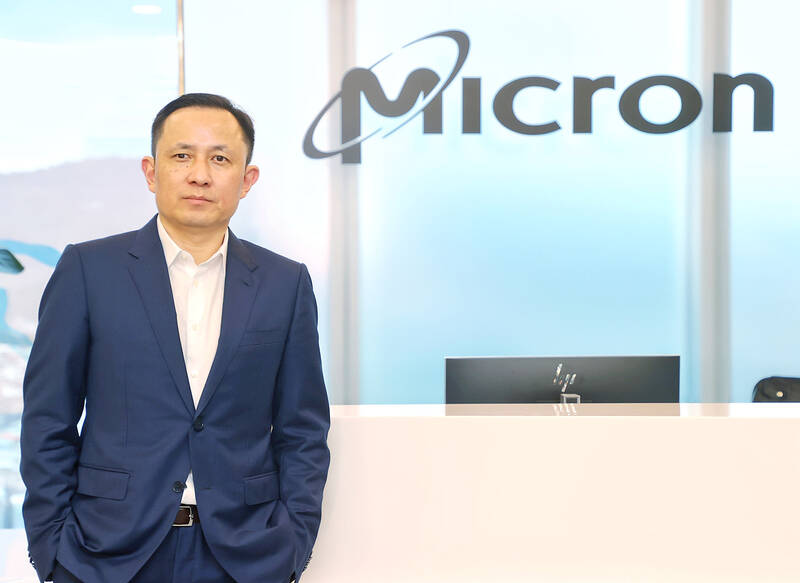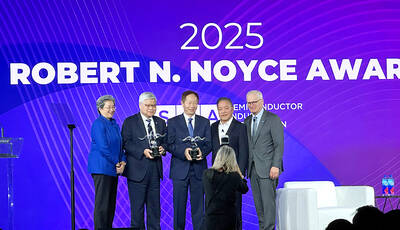Taiwan has a well-established ecosystem for producing semiconductors, which is why Micron Technology Inc has decided to produce its most advanced DRAM chips in the country, corporate vice president and head of Micron Taiwan Donghui Lu (盧東暉) said in an exclusive interview with the Central News Agency.
Micron Technology announced in May that it would mass produce DRAM chips on its most advanced 1-gamma node in its fab in Taichung in 2025, ahead of any other production site worldwide.
The 1-gamma node would use cutting-edge extreme ultraviolet (EUV) lithography production equipment. It would be the first Micron DRAM process node to use EUV technology. The process was jointly developed by Micron research and development teams in Taiwan and Japan.

Photo: CNA
Despite the debated geopolitical risks and calls for the “de-Taiwanization” of chipmaking, Lu said that Micron’s investment strategy has not changed, adding that he does not believe these negative sentiments have clouded Taiwan’s prospects in the industry.
“If you can beat your competitors in terms of product quality to the point where there are no alternatives, there is no need to worry because silicon never lies,” Lu said.
The Micron Taiwan head said high bandwidth memory (HBM) and 1-beta and 1-gamma process technology all cost money that can only be spent in Taiwan.
HBM is a new type of 3D memory that vertically stacks memory chips. It is designed to keep up with the performance and power efficiency of resource-intensive applications such as data centers and artificial intelligence.
Micron’s HBM has been facilitated by the 1-beta DRAM process node, which is followed by the latest 1-gamma node.
Taiwan and Japan are the only two production sites for Micron’s DRAM. More than 65 percent of Micron’s DRAM products are manufactured in Taiwan. The Japanese fab started mass producing 1-beta node DRAM chips in October last year, with its Taiwan fab following suit.
Production capacity is expected to expand in the two countries over the next few years, Lu said.
There are several reasons that Taiwan would remain an important investment destination for Micron, he said.
One is that Taiwan’s ecosystem is well-established, and it is difficult for other countries to achieve the same level in the span of a few years, he said.
Another reason is that the semiconductor industry has a long history in Taiwan, so the government, local enterprises and human resources are all highly familiar with the industry, Lu said.
With many countries readjusting their view of the global supply chain following the COVID-19 pandemic, and amidst continuing US-China tensions and the rebranding of the semiconductor industry as a national security priority, supply chain localization is on the rise.
Micron responded to the US government’s calls for domestic manufacturing by making major investments in the US last year. Many worried that the company’s investments in Taiwan would be adversely affected as a result.
However, Lu said the chip industry is globalized and Micron has customers all over the world.
The company would continue providing services to its customers with advanced techniques and would not leave Taiwan for geopolitical reasons, he said, adding that Micron would also continue to grow in Japan and the US to build a more resilient supply chain and be closer to its customers.
Taiwan has a clear advantage in keeping foreign investment, he said.
“While the US and Europe both want to build their own supply chains, Taiwan has spent 40 years achieving the scale it has now. It is an achievement of accumulation that cannot be achieved in one leap.”

Shiina Ito has had fewer Chinese customers at her Tokyo jewelry shop since Beijing issued a travel warning in the wake of a diplomatic spat, but she said she was not concerned. A souring of Tokyo-Beijing relations this month, following remarks by Japanese Prime Minister Sanae Takaichi about Taiwan, has fueled concerns about the impact on the ritzy boutiques, noodle joints and hotels where holidaymakers spend their cash. However, businesses in Tokyo largely shrugged off any anxiety. “Since there are fewer Chinese customers, it’s become a bit easier for Japanese shoppers to visit, so our sales haven’t really dropped,” Ito

The number of Taiwanese working in the US rose to a record high of 137,000 last year, driven largely by Taiwan Semiconductor Manufacturing Co’s (TSMC, 台積電) rapid overseas expansion, according to government data released yesterday. A total of 666,000 Taiwanese nationals were employed abroad last year, an increase of 45,000 from 2023 and the highest level since the COVID-19 pandemic, data from the Directorate-General of Budget, Accounting and Statistics (DGBAS) showed. Overseas employment had steadily increased between 2009 and 2019, peaking at 739,000, before plunging to 319,000 in 2021 amid US-China trade tensions, global supply chain shifts, reshoring by Taiwanese companies and

Taiwan Semiconductor Manufacturing Co (TSMC) Chairman C.C. Wei (魏哲家) and the company’s former chairman, Mark Liu (劉德音), both received the Robert N. Noyce Award -- the semiconductor industry’s highest honor -- in San Jose, California, on Thursday (local time). Speaking at the award event, Liu, who retired last year, expressed gratitude to his wife, his dissertation advisor at the University of California, Berkeley, his supervisors at AT&T Bell Laboratories -- where he worked on optical fiber communication systems before joining TSMC, TSMC partners, and industry colleagues. Liu said that working alongside TSMC

TECHNOLOGY DAY: The Taiwanese firm is also setting up a joint venture with Alphabet Inc on robots and plans to establish a firm in Japan to produce Model A EVs Manufacturing giant Hon Hai Precision Industry Co (鴻海精密) yesterday announced a collaboration with ChatGPT developer OpenAI to build next-generation artificial intelligence (AI) infrastructure and strengthen its local supply chain in the US to accelerate the deployment of advanced AI systems. Building such an infrastructure in the US is crucial for strengthening local supply chains and supporting the US in maintaining its leading position in the AI domain, Hon Hai said in a statement. Through the collaboration, OpenAI would share its insights into emerging hardware needs in the AI industry with Hon Hai to support the company’s design and development work, as well